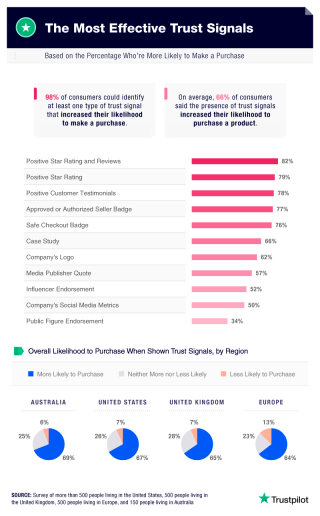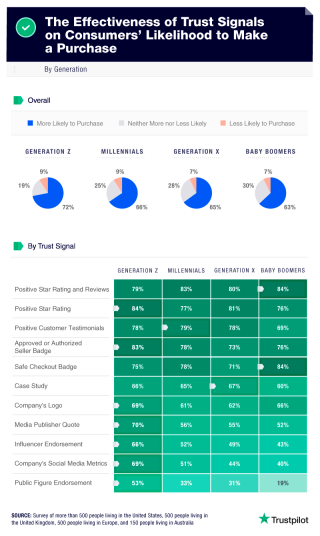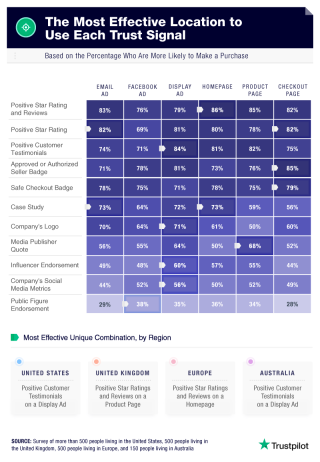Why and How Social Proof Influences Consumers Essay.
When consumers think about buying a product or service, they don’t just consider ads, features, and benefits. They also strongly consider the social proof that reinforces those messages and claims.
Social proof — reviews, social likes, online mentions, and testimonials for products, services, or brands — has a powerful psychological effect on customers. Why and How Social Proof Influences Consumers Essay. Because the feedback comes from other consumers, not the brand itself, the positive messaging surrounding a product or service can be perceived as more authentic and trustworthy. Consumers see social proof as an endorsement from their peers saying that the company, service, or product is great, and that the overall customer journey has satisfied previous shoppers.
ORDER A CUSTOM-WRITTEN, PLAGIARISM-FREE PAPER HERE
So when customers see trust signals — visual representations of social proof such as badges, ratings, reviews, and logos — it understandably elicits a strong influence on shopping behavior.
According to our recent research, almost all consumers (98%) could identify at least one type of trust symbol that increased their likelihood to make a purchase.
If brands want to effectively turn interested prospects into paying customers, they need to take advantage of external validation in order to influence potential customers, and understand how social proof impacts the way consumers make purchasing decisions. Why and How Social Proof Influences Consumers Essay.
To find out exactly how social proof influences the purchasing process and which trust signals are the most important, we surveyed nearly 1,700 consumers across multiple regions (United States, United Kingdom, Australia, and many European countries) and generations (baby boomers, Gen Xers, millennials, and Gen Zers), and found that:
- An average of sixty-six percent of customers said the presence of social proof increased their likelihood to purchase a product.
- Positive star ratings and reviews were the most important trust symbol. Eighty-two percent said it made them more likely to make a purchase.
- Positive star ratings and reviews on the homepage were the trust signals most likely to drive customers to make a purchase (86%). Positive star ratings and reviews on a product page were the second most likely, influencing 85% of customers. Why and How Social Proof Influences Consumers Essay.
- Customers prefer different trust signals throughout the buying journey. Media mentions (52%) and endorsements from public figures (50%) were effective when customers performed initial online research, while testimonials (60%) and star ratings and reviews (50%) were effective when customers compared different retailers.
Want to learn more? Let’s dive deeper into the research to see which signals are most important to consumers, and how the appearance of signals affects different demographics during the purchasing process.
Breaking down how social proof influences consumers
At one time, brands could use ads to inform consumers, build trust, and drive customers to buy. But this is no longer the case. Consumers are increasingly aware of and, therefore, unaffected by ads, and it is this change that led to the rise of user-generated content and huge influence of social proof.
Customers used to rely solely on advertisements and word of mouth when determining what to purchase. Now, they also look to social proof.
There are four primary principles of social proof that influence customers in ways that ads can’t (and never could):
- Uncertainty: Customers look to social proof for guidance when they are in unfamiliar situations.
- Similarity: Customers gather and use feedback from sources and people they personally relate to. Why and How Social Proof Influences Consumers Essay.
- Expertise: Customers value opinions and verification from people who are more knowledgeable or experienced than themselves.
- Number: Customers consider the number of satisfied customers before them, and the resulting trust signals they find, as a reason to buy or walk away.
Social proof has technically been around since the dawn of marketing. Quotes from happy customers have been appearing on marketing materials as long as marketing materials have been produced.
ORDER A CUSTOM-WRITTEN, PLAGIARISM-FREE PAPER HERE
But today, social proof is more influential than ever because sharing our own experience and reading about others’ experiences is a native element of life online. Customers need help with their purchasing decisions, and social proof offers the authentic, transparent guidance that customers want and crave. Why and How Social Proof Influences Consumers Essay.
This is why 98% of customers could identify at least one trust symbol that would increase their likelihood to buy.
Our data only confirmed that social proof strongly influences consumers, but it also showed that some trust signals influence customers more than others.

In the eyes of shoppers, some trust signals mean more than others
Of all of the trust signals mentioned, reviews, star ratings, and testimonials are the most important to customers. Positive star ratings and reviews ranked as the most effective (82%) followed by positive star ratings alone (79%), and positive customer testimonials (78%). Why and How Social Proof Influences Consumers Essay.
On-site badges were the next most influential trust symbol. Customers were more likely to purchase when they saw an approved or authorised seller badge (77%), or a safe checkout badge (76%).
Interestingly, the power of social proof appears to be universal. Customers all over the world were similarly influenced by trust signals. Overall, the region where a consumer lived didn’t significantly impact the way he or she was influenced by signals. Social proof was slightly more effective among Australians and Americans, but Europeans weren’t far behind.
That said, our research did find that generational differences do impact the overall influence of trust signals.

Tailoring trust signals to customer demographics
Our survey results revealed an interesting pattern: the younger customers are, the more likely they are to be influenced by trust signals. In fact, there was a significant gap between Gen Zers, the youngest generation of consumers, and the other generations. In fact, 72% of Gen Zers were more likely to purchase based on social proof versus 66% of millennials, 65% of Gen Xers, and 63% of baby boomers. Why and How Social Proof Influences Consumers Essay.
This data shows that trust signals are becoming even more important, as the next generation of shoppers clearly embraces them more than past consumers, and continues to age into greater spending and purchasing power.
The different generations not only value social proof with varying degrees of importance, but they also value different types of trust signals. Baby boomers were more responsive to safe checkout badges than the other generations, showing they value security when purchasing online, which could indicate an enduring air of skepticism around life online that is noticeably absent in digital natives. In contrast, Gen Zers were much more receptive to media publisher quotes, influencer endorsements, social media metrics, and endorsements from public figures, showing they value third-party opinions from individuals over institutions.
As a brand, it’s essential to understand who your customers are so you can identify and share the trust signals that matter most to them. Why and How Social Proof Influences Consumers Essay.

How trust signals influence shoppers at each touch point
So far, we’ve established that social proof has a strong influence over customers, and this influence affects the way they think while determining if they want to buy from a brand.
Even where a trust symbol is viewed within the customer journey can influence the way a shopper thinks about his or her potential purchase. In our study, we used A/B testing to show different combinations of trust signals in locations where a consumer might encounter a trust symbol during the purchase process: marketing emails, digital advertisements, and on the retailer’s home or product pages
We found that no matter where they appear in the journey, star ratings, reviews, and testimonials made customers more likely to make a purchase. Customers were most likely to make a purchase when they saw a positive star rating and reviews on the homepage (86%) and product page (85%), although reviews were also impactful in email ads, Facebook ads, display ads, and checkout pages as well.
Using trust signals in the right place, at the right time
No matter the industry, all marketing efforts seem to work better when they feature trust signals. However, it’s important to note that they can work differently at different stages of the purchasing funnel. Customers look for — and value — different elements of social proof as they work their way closer to a purchase. Why and How Social Proof Influences Consumers Essay.
Media mentions and public figure endorsements were perceived as most beneficial early in the buying process. Next, customers valued testimonials and star ratings while they shopped around and compared different brands. Then, once a consumer was ready to buy, authorised seller badges became the most effective trust symbol.
For a trust symbol to work effectively, it needs to be delivered to the right audience, and used at each stage of the buying process, in order to give customers the sense of transparency they need to feel comfortable making their final purchase.
Trust signals make the buying decision easy
Customers no longer base their purchasing decisions on what they hear and read in ads. In fact, they can often tune out these messages completely. In our networked and logged on culture, messaging from a company no longer provides customers the information and proof they need to trust a brand and buy from them – social proof and trust signals do.
ORDER A CUSTOM-WRITTEN, PLAGIARISM-FREE PAPER HERE
The ability to optimise one’s use of trust signals can even be seen between promoting a product or service. Although trust signals were comparably beneficial for both, positive star ratings saw slightly higher influence when paired with a product offering, while approved and authorised seller badges gave customers the ease of mind to consider a service offering.
Social proof, especially authentic third-party reviews and ratings, are now one of the most influential forces that guide customers as they make purchasing decisions. With 98% of customers saying they could identify at least one type of trust symbol that increased their likelihood to make a purchase, these factors influence consumers all across the world, in all generations, and all stages of the buyer’s journey. Why and How Social Proof Influences Consumers Essay.
If you want your brand to stay competitive in your market, attract new consumers, and effectively turn interested prospects into paying customers, you need to take notice.
Create a plan to give customers what they need to feel comfortable buying from you. Start building social proof elements that consumers want, need, and trust.
Methodology
We collected responses from 1,697 consumers on questions related to their shopping behavior and the influence of social proof signals. 30% of respondents lived in the United States, 30% lived in the United Kingdom, 9% lived in Australia, and 32% lived in other European countries. Why and How Social Proof Influences Consumers Essay.
Limitations
Many other factors influence the shopping behavior in relation to social proof. While we included many of these factors, every individual chooses to purchase a product based on his or her personal reasons. This study is based solely on means and self-reported data. No statistical testing was performed and as such, this data is exploratory.
Fair Use Statement
Know a company leader looking to improve or begin building his or her online reputation? Please feel free to share the results of our study with them for noncommercial purposes. We also ask that you link back to this page to give credit to its authors. Why and How Social Proof Influences Consumers Essay.